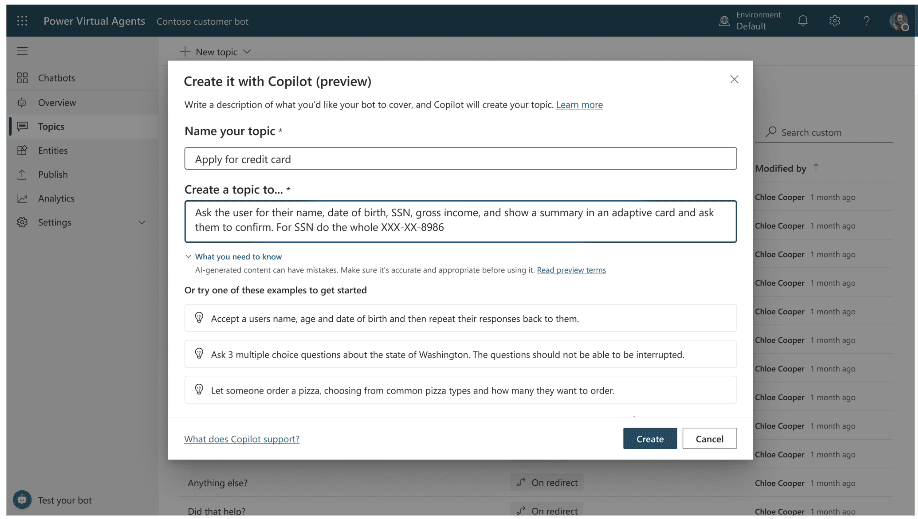What’s New With Microsoft’s Power Platform – May 2023

As a true Power Platform guy, I watched the breaking headlines from Microsoft Build 2023 last month and came away with 2 words to caption the bulk of it: Copilot Everywhere! Microsoft’s powerful AI service is making its way into various Power Platform and Microsoft 365 products. Imagine having an intelligent assistant at your fingertips that integrates with the tools you’ve grown comfortable using and the data that drives your company? That’s what Microsoft is trying to achieve with its various Copilot announcements.
Copilot integration with Power Platform products
The new Copilot for Power Pages is designed to assist with copy-editing and text and layout generation using natural language prompts. You’ll even be able to embed a Power Virtual Agent (PVA) chatbot into your Power Pages that uses natural language models to have a more free-flowing conversation with your site visitors. What is truly amazing about Copilot’s integration into our favorite and even lesser-used products is that it can take your prompt and help you to build the solution you want, even if you don’t necessarily have the time or know-how to build it yourself.
The Microsoft 365 Copilot, which is currently available in private preview, will be able to sit over all your data, and then you will interact with it just like prompting ChatGPT or Bing Chat. However, there’s a distinction here I don’t want you to miss: We’re traditionally trained to think of these AI assistants as natural-language search engines. It used to be that you would type in a keyword to a search engine, and it would bring up the top matching websites or documents.
However, as AI assistants have begun popping up, there’s more to them than just keyword searches, because the AI understands the data around the matches it comes up with. And on top of that, it isn’t just parsing through documents and files looking for matching metadata: It can crawl through your data tables and understand more about your data, then take relevant action based on that data. This is what revolutionizes the platform.
Along with the Copilot integration into Power Automate, Power Automate’s flow design studio is finally getting a facelift. Obviously, the Copilot stuff is great. Being able to describe in natural language what I want my flow to do, and then let Copilot do the heavy lifting in assembling the pieces to make that happen is exactly what I wanted an AI assistant in Power Automate to do. But in addition to that, the larger Expression editor brought a tear to my eye.
If there’s a jaw-dropping feature to top all jaw-dropping features in these announcements, Copilot for PVA chatbots just might be the one. Not only do I love the idea of using a natural language prompt to help me build my chatbot, but that chatbot being automatically powered by the new language models and being able to interact with both my customers and my company data has me blown away by just how simple yet effective it is.

New Power Apps Homescreen, starting templates, and start from Excel
The Power Apps home screen got a facelift as part of Microsoft’s Build 2023 announcements. This new home screen is designed to make getting started with Power Apps easier for everyone. It does so by breaking out the home screen into 3 starting points, “Start with Data”, “Start with Page Design”, and “Start with app template”.
The standout feature under the “Start with Data” section is the innovative “Upload an Excel file” option. With a few clicks, you can transform your static Excel data into a dynamic Power App. The process is as straightforward as it is ingenious.
Once you’ve selected your Excel file to upload, the system retrieves the data and presents a preview of a Dataverse table based on the information from your spreadsheet. This step gives you a visual representation of how your data will be structured and allows for adjustments to ensure it fits your needs perfectly.
After any necessary modifications, hitting “Create App” brings your data to life. The system generates a Dataverse table from your data, seamlessly importing all your Excel information into this table. But the magic doesn’t stop there.
In the next stage, a responsive Power App is built automatically to work harmoniously with your newly created Dataverse table. This entire process, from Excel upload to app creation, happens in a blink – mere seconds. The result is a robust, personalized application, ready for you to explore and utilize.
This new feature epitomizes the spirit of Power Apps: transforming data handling from a mundane task into an exciting journey of discovery and innovation. If you want a walkthrough of how to use the new Excel feature, you can check out my demo video.
Custom Dataverse plugins
When you’ve got complex operations that you need to automate, you’re probably accustomed to going to Power Automate for a flow or even putting custom code into an Azure Function. However, with custom Dataverse plugins, you can write out these operations using PowerFX, the same code base powering your Power Apps and Virtual Agents, and keep it all within the Dataverse platform.
The power of these plugins isn’t relegated to those super nerdy cases, though. Remember how Microsoft really wants us to stop putting hundreds of lines of variables and collection initializations in our App OnStart property? Guess what, custom Dataverse plugins make for a very powerful alternative, allowing you to offload all that data to the server and really streamline your app loading process.
A new era of AI assistance and collaboration
There is so much that Microsoft announced at Build for us Power Platform fans to get excited about. Copilot is a major piece, but it isn’t the only one. I’ve highlighted just a few of my favorite announcements in this article.
One thing that I kept thinking through all of them is that we’re witnessing a new era of AI assistance and collaboration. With Copilot seamlessly integrated into various Power Platform products, users are empowered to unleash their creativity and achieve their desired outcomes, even without extensive technical expertise.



